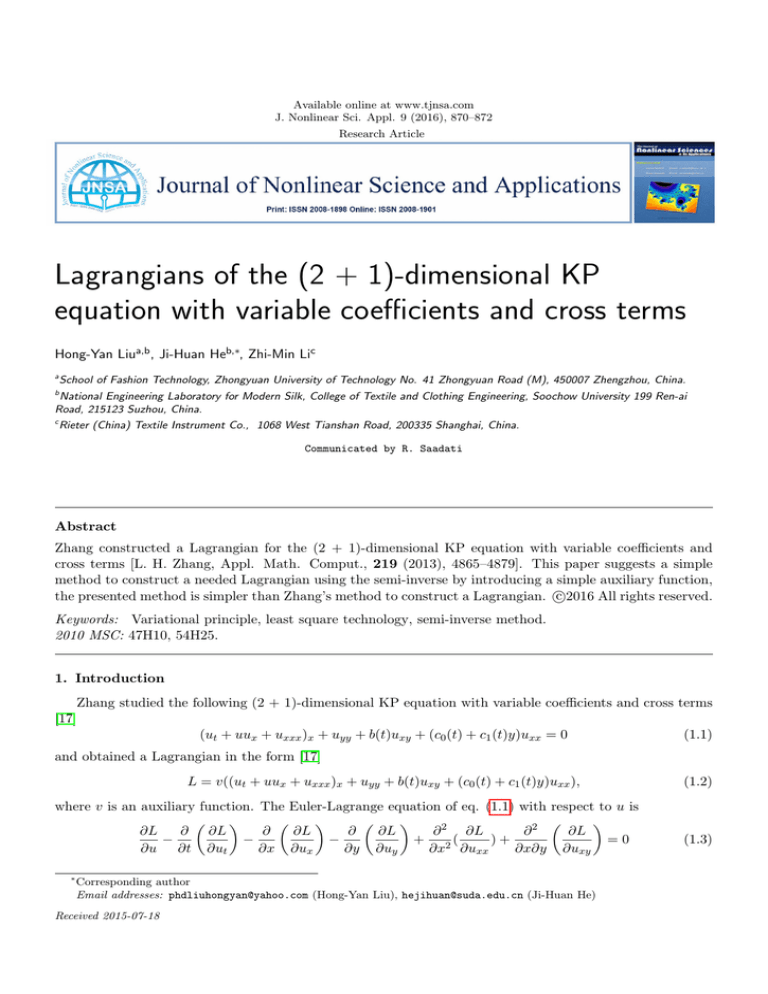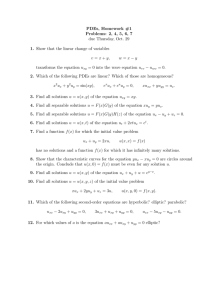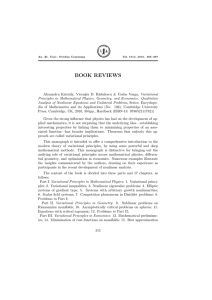
Available online at www.tjnsa.com
J. Nonlinear Sci. Appl. 9 (2016), 870–872
Research Article
Lagrangians of the (2 + 1)-dimensional KP
equation with variable coefficients and cross terms
Hong-Yan Liua,b , Ji-Huan Heb,∗, Zhi-Min Lic
a
School of Fashion Technology, Zhongyuan University of Technology No. 41 Zhongyuan Road (M), 450007 Zhengzhou, China.
b
National Engineering Laboratory for Modern Silk, College of Textile and Clothing Engineering, Soochow University 199 Ren-ai
Road, 215123 Suzhou, China.
c
Rieter (China) Textile Instrument Co., 1068 West Tianshan Road, 200335 Shanghai, China.
Communicated by R. Saadati
Abstract
Zhang constructed a Lagrangian for the (2 + 1)-dimensional KP equation with variable coefficients and
cross terms [L. H. Zhang, Appl. Math. Comput., 219 (2013), 4865–4879]. This paper suggests a simple
method to construct a needed Lagrangian using the semi-inverse by introducing a simple auxiliary function,
c
the presented method is simpler than Zhang’s method to construct a Lagrangian. 2016
All rights reserved.
Keywords: Variational principle, least square technology, semi-inverse method.
2010 MSC: 47H10, 54H25.
1. Introduction
Zhang studied the following (2 + 1)-dimensional KP equation with variable coefficients and cross terms
[17]
(ut + uux + uxxx )x + uyy + b(t)uxy + (c0 (t) + c1 (t)y)uxx = 0
(1.1)
and obtained a Lagrangian in the form [17]
L = v((ut + uux + uxxx )x + uyy + b(t)uxy + (c0 (t) + c1 (t)y)uxx ),
where v is an auxiliary function. The Euler-Lagrange equation of eq. (1.1) with respect to u is
∂ ∂L
∂
∂L
∂
∂L
∂ 2 ∂L
∂2
∂L
∂L
−
−
−
+ 2(
)+
=0
∂u ∂t ∂ut
∂x ∂ux
∂y ∂uy
∂x ∂uxx
∂x∂y ∂uxy
∗
Corresponding author
Email addresses: phdliuhongyan@yahoo.com (Hong-Yan Liu), hejihuan@suda.edu.cn (Ji-Huan He)
Received 2015-07-18
(1.2)
(1.3)
H.-Y. Liu, J.-H. He, Z.-M. Li, J. Nonlinear Sci. Appl. 9 (2016), 870–872
871
or
vtx − 2(vux )x + vuxx + (vu)xx + vxxxx + vyy + b(t)vxy + (c0 (t) + c1 (t)y)vxx = 0.
(1.4)
Simplification of Eq. (1.4) results in
vtx + vxx u + vxxxx + vyy + b(t)vxy + (c0 (t) + c1 (t)y)vxx = 0.
(1.5)
The auxiliary function, v, in Eq. (1.2) must satisfy Eq. (1.5).
Remark 1.1. Equation (1.2) is similar to those by the Galerkin technology [16] which is widely used in the
finite element method.
d
the Galerkin method is
For a general linear equation Au = 0, where A is an operator e.g., A = dx
Z
J(u, v) = Ldtdxdy,
(1.6)
where v is auxiliary function, L is a Lagrange function defined as
L = vAu,
(1.7)
Au = 0
(1.8)
Av = 0.
(1.9)
the Euler-Lagrange equations of Eq. (1.6) are
and
So Eq. (1.2) is similar to Galerkin technology.
Remark 1.2. There is an exact Lagrangian for the following equation
(ut + uxxx )x + uyy + b(t)uxy + (c0 (t) + c1 (t)y)uxx = 0.
(1.10)
By the semi-inverse method [1], [3]–[6], [8], we can obtain the Lagrangian for Eq. (1.10), which reads
1
1
b(t)
1
1
L = − ut ux + (uxx )2 − (uy )2 −
ux uy − (c0 (t) + c1 (t)y)(ux )2 .
2
2
2
2
2
Remark 1.3. An approximate Lagrangian can be obtained for Eq. (1.1), which is
1
1
1
b(t)
1
L = − ut ux + (uxx )2 − (uy )2 −
ux uy − (c0 (t) + c1 (t)y)(ux )2 − wux ,
2
2
2
2
2
where w is an auxiliary function defined by
w = uux .
(1.11)
(1.12)
(1.13)
Remark 1.4. An generalized Lagrangian can obtained by the semi-inverse method [3]–[6], [8], which reads
1
1
1
b(t)
1
L(u, w) = − ut ux + (uxx )2 − (uy )2 −
ux uy − (c0 (t) + c1 (t)y)(ux )2 − wux + λ(w − uux )2 , (1.14)
2
2
2
2
2
where λ 1 is a nonzero constant.
Proof. The Euler-Lagrange equations of Eq. (1.14) with respect to u and w are
(ut + uxxx )x + uyy + b(t)uxy + (c0 (t) + c1 (t)y)uxx + wx − 2λ(wx − uux )ux + 2λ((wx − uux )u)x = 0, (1.15)
− ux + 2λ(w − uux ) = 0.
(1.16)
Considering λ 1, saying λ = 1010 , Eq. (1.16) is approximated as
w − uux = 0.
(1.17)
Submitting Eq. (1.17) into Eq. (1.15) results in Eq. (1.1).
Similar results can be obtained for the Burgers equation [17] by the semi-inverse method [3]–[6], [8].
Some illustrating examples for construction of Lagrangian of a nonlinear equation are available in Refs
[2, 7, 9, 10, 11, 12, 13, 14, 15, 18].
H.-Y. Liu, J.-H. He, Z.-M. Li, J. Nonlinear Sci. Appl. 9 (2016), 870–872
872
Acknowledgments:
The work is supported by PAPD (A Project Funded by the Priority Academic Program Development of Jiangsu Higher Education Institutions); Jiangsu Province Key Laboratory No.KJS1314, Jiangsu
Planned Projects for Postdoctoral Research Funds 1401076B and China Postdoctoral Science Foundation
2015M571806.
References
[1] S. Das, R. Kumar, Fractional diffusion equations in the presence of reaction terms, J. Comput. Complex. Appl.,
1 (2015), 15–21. 1
[2] D. D. Fei, F. J. Liu, P. Wang, H. Y. Liu, A short remark on He-Lee’s variational principle for heat conduction,
Therm. Sci., 17 (2013), 1561–1563. 1
[3] J. H. He, Variational principles for some nonlinear partial differential equations with variable coefficients, Chaos
Solitons Fractals, 19 (2004), 847–851. 1, 1.4, 1
[4] J. H. He, Some asymptotic methods for strongly nonlinear equations, Internat. J. Modern Phys. B, 20, (2006),
1141–1199.
[5] J. H. He, An elementary introduction to recently developed asymptotic methods and nanomechanics in textile
engineering, Internat. J. Modern Phys. B, 22 (2008), 3487–3578.
[6] J. H. He, Asymptotic methods for solitary solutions and compactons, Abstr. Appl. Anal., 2012 (2012), 130 pages.
1, 1.4, 1
[7] Z. Jia, M. Hu, Q. Chen, Variational principle for unsteady heat conduction equation, Therm. Sci., 18 (2014),
1045–1047. 1
[8] X. W. Li, Y. Li, J. H. He, On the semi-inverse method and variational principle, Therm. Sci., 17 (2013), 1565–
1568. 1, 1.4, 1
[9] Z. B. Li, J. Liu, Variational formulations for soliton equations arising in water transport in porous soils, Therm.
Sci., 17 (2013), 1483–1485. 1
[10] Z. L. Tao, Solitary solutions of the Boiti-Leon-Manna-Pempinelli equation using He’s variational method, Z.
Naturforsch A, 63 (2008), 634–636. 1
[11] Z. L. Tao,Variational approach to the Benjamin Ono equation, Nonlinear Anal. Real World Appl., 10 (2009),
1939–1941. 1
[12] Z. L. Tao, G. H. Chen,Remark on a constrained variational principle for heat conduction, Therm. Sci., 17 (2013),
951–952. 1
[13] G. Wu, D. Baleanu, Z. Deng, Variational iteration method as a kernel constructive technique, Appl. Math Model.,
39 (2015), 4378–4384. 1
[14] L. Xu,Variational approach to solitons of nonlinear dispersive K(m, n) equations, Chaos Solitons Fractals, 37
(2008), 137–143. 1
[15] L. Yao, How to discover a variational principle for a damped vibration problem, Int. J. Nonlinear Sci. Numer.
Sim., 11 (2010), 171–174. 1
[16] S. A. Yousefi, Z. Barikbin, M. Dehghan, Ritz-Galerkin method with Bernstein polynomial basis for finding the
product solution form of heat equation with non-classic boundary conditions, Internat. J. Numer. Methods Heat
Fluid Flow, 22 (2012), 39–48. 1.1
[17] L. H. Zhang, Conservation Laws of the (2 + 1)-dimensional KP equation and Burgers equation with variable
coefficients and cross terms, Appl. Math. Comput., 219 (2013), 4865–4879. 1, 1, 1
[18] X. W. Zhou, L. Wang, A variational principle for coupled nonlinear Schrodinger equations with variable coefficients
and high nonlinearity, Comput. Math. Appl., 61 (2011), 2035–2038. 1









